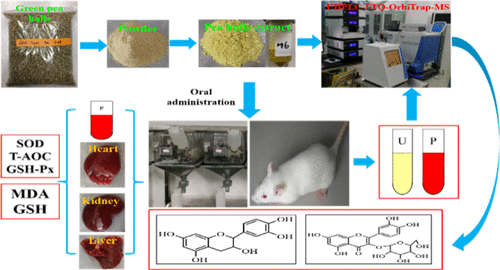当前位置:
X-MOL 学术
›
J. Agric. Food Chem.
›
论文详情
Our official English website, www.x-mol.net, welcomes your
feedback! (Note: you will need to create a separate account there.)
Phenolics of Green Pea (Pisum sativum L.) Hulls, Their Plasma and Urinary Metabolites, Bioavailability, and in Vivo Antioxidant Activities in a Rat Model.
Journal of Agricultural and Food Chemistry ( IF 5.7 ) Pub Date : 2019-10-17 , DOI: 10.1021/acs.jafc.9b04501 Fanghua Guo 1 , Hua Xiong 1 , Xiaoya Wang 1 , Li Jiang 2 , Ningxiang Yu 1 , Zhenying Hu 1 , Yong Sun 1 , Rong Tsao 3
Journal of Agricultural and Food Chemistry ( IF 5.7 ) Pub Date : 2019-10-17 , DOI: 10.1021/acs.jafc.9b04501 Fanghua Guo 1 , Hua Xiong 1 , Xiaoya Wang 1 , Li Jiang 2 , Ningxiang Yu 1 , Zhenying Hu 1 , Yong Sun 1 , Rong Tsao 3
Affiliation

|
Increased processing of pulses generates large volumes of hulls, which are known as an excellent source of phenolic antioxidants. However, the bioavailability and in vivo activity of these phenolics are rarely reported. This research was therefore carried out to study the absorption, metabolism, and in vivo antioxidant activities of green pea hull (GPH) phenolics using ultrahigh-pressure liquid chromatography with a linear ion trap-high-resolution Orbitrap mass spectrometry and an oxidative stress rat model. A total of 31 phenolics, including 4 phenolic acids, 24 flavonoids, and 3 other phenolics, were tentatively identified. Ten of these phenolics and 49 metabolites were found in the plasma and urine of rats, which helped to explain the favorable changes by GPH phenolics in key antioxidant enzymes (superoxide dismutase, glutathione peroxidase, and glutathione) and indicators (total antioxidant capacity, malondialdehyde) in the plasma and different tissues of rats. This is the first comprehensive report on dry pea hull phenolics and their bioavailability, metabolic profiles, and mechanisms of in vivo antioxidant activities.
中文翻译:

青豌豆 (Pisum sativum L.) 壳的酚类物质、其血浆和尿液代谢物、生物利用度以及大鼠模型中的体内抗氧化活性。
豆类加工的增加会产生大量的豆壳,这些豆壳被认为是酚类抗氧化剂的极好来源。然而,这些酚类物质的生物利用度和体内活性却鲜有报道。因此,本研究采用超高压液相色谱、线性离子阱-高分辨率 Orbitrap 质谱和氧化应激大鼠模型来研究绿豌豆壳 (GPH) 酚类物质的吸收、代谢和体内抗氧化活性。 。初步鉴定出31种酚类化合物,其中酚酸类化合物4种,黄酮类化合物24种,其他酚类化合物3种。在大鼠血浆和尿液中发现了其中的10种酚类物质和49种代谢物,这有助于解释GPH酚类物质对关键抗氧化酶(超氧化物歧化酶、谷胱甘肽过氧化物酶和谷胱甘肽)和指标(总抗氧化能力、丙二醛)的有利变化存在于大鼠血浆和不同组织中。这是第一份关于干豌豆壳酚类物质及其生物利用度、代谢特征和体内抗氧化活性机制的综合报告。
更新日期:2019-10-17
中文翻译:

青豌豆 (Pisum sativum L.) 壳的酚类物质、其血浆和尿液代谢物、生物利用度以及大鼠模型中的体内抗氧化活性。
豆类加工的增加会产生大量的豆壳,这些豆壳被认为是酚类抗氧化剂的极好来源。然而,这些酚类物质的生物利用度和体内活性却鲜有报道。因此,本研究采用超高压液相色谱、线性离子阱-高分辨率 Orbitrap 质谱和氧化应激大鼠模型来研究绿豌豆壳 (GPH) 酚类物质的吸收、代谢和体内抗氧化活性。 。初步鉴定出31种酚类化合物,其中酚酸类化合物4种,黄酮类化合物24种,其他酚类化合物3种。在大鼠血浆和尿液中发现了其中的10种酚类物质和49种代谢物,这有助于解释GPH酚类物质对关键抗氧化酶(超氧化物歧化酶、谷胱甘肽过氧化物酶和谷胱甘肽)和指标(总抗氧化能力、丙二醛)的有利变化存在于大鼠血浆和不同组织中。这是第一份关于干豌豆壳酚类物质及其生物利用度、代谢特征和体内抗氧化活性机制的综合报告。




















































 京公网安备 11010802027423号
京公网安备 11010802027423号